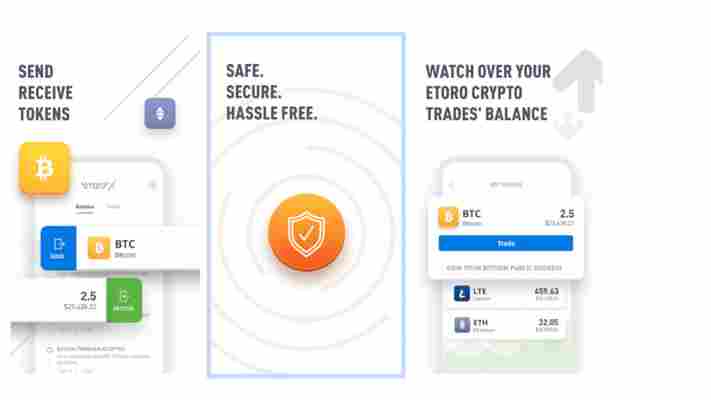Social trading platform eToro has finally begun rolling out its cryptocurrency wallet to Android and iOS users.

The wallet, which promises an intuitive customer interface and enhanced security, is now available on Google Play and Apple’s App Store. At launch, the app will support only Bitcoin, Bitcoin Cash, Ethereum, and Litecoin; however, eToro plans to add support for more cryptocurrencies in the near future.
There is a little catch though: to ensure a smooth customer experience, eToro is releasing the wallet only to select users and countries. So if you can’t find the app on Google Play or the App Store, you might have to wait a little longer.
“We believe that crypto and the blockchain technology that underpins it will have a huge impact on global finance,” said Yoni Assia, CEO of eToro. “Blockchain has the potential to revolutionise finance and we believe that we will see the greatest transfer of wealth ever onto the blockchain.”
“We believe that in the future all assets will be tokenised and that crypto is just the first step on this journey,” he continued. “Just as eToro has opened up traditional markets for investors, we want to do the same in a tokenised world. The eToro wallet is a key part of this.”
The company initially revealed plans to release its own standalone wallet app back in May. It also teased a new cryptocurrency-only exchange desk, slated to launch in Europe and later in the US.
For the time being, eToro says the ability to transfer cryptocurrency from eToro to the wallet will be open only to Platinum Club members for Bitcoin. The goal is to gradually extend the functionality to more users and assets.
“The eToro wallet today is just the beginning and we will adding a whole host of additional functionality which will include supporting additional crypto and fiat tokens, crypto to crypto conversion, the ability to deposit fiat, payment in store and more,” Assia added.
Financial overlords are spreading cryptocurrency misinformation disguised as ‘research’
As blockchain tech continues to find growing popularity, a large number of mainstream financial institutions are jumping in to provide their insights and opinions. But despite years of experience in the world of finance, it seems that many of these institutions are still struggling to understand the pros and cons of cryptocurrencies.

The initial responses to Bitcoin were simply that it is a “bubble,” “money for drug dealers and terrorists,” and the like. But now that we are past that phase ( at least. most of us ), the focus has shifted to studying cryptocurrencies more in depth. But, studying some of these recent reports suggests that the ‘in-depth’ studies are mostly bringing out superficial results.
Flawed Rankings
The latest offender is the China Electronic Information Industry Development (CCID) – the research wing of China’s Ministry of Industry and Information Technology (MIIT) – which recently published its second-ever blockchain report.
The study, which aims to “evaluate the development level of global public-owned chain technology [and] accurately grasp the trend of blockchain,” rated controversial startup EOS as the top cryptocurrency on its list. That is despite the avalanche of difficulties EOS has had to fight off in the past several weeks.
To give you a recap, EOS’s development has been far from ideal . The mainnet launch — which was slated to happen on June 2 was delayed for more than a week — as it battled constant discovery of vulnerabilities in its blockchain. The cryptocurrency also saw multiple controversies regarding its “on-chain governance” model , which it is reportedly now scrapping.
Yet the report fails to mention any of this. Here is how it sums up EOS instead:
Not only does the CCID fail to provide any insight into EOS past its marketing statement, but it also misses to point out that the platform is extremely new and yet to prove its claims.
While it is difficult to justify ranking such a nascent cryptocurrency over other established and somewhat well-proven blockchain solutions, the real issue is not ranking EOS as the top dog. It is how arbitrarily the CCID reached this conclusion.
But it is even more concerning that this is hardly the first time the CCID has provided poorly researched ratings.
In its previous rankings, CCID dubiously ranked Verge cryptocurrency over Bitcoin in terms of technology. Indeed, the report gives Bitcoin a score of 39.4 in comparison to Verge’s 66.1 (out of 100). This is a confounding take, given that Verge suffered at least three 51 percent attacks in recent months. This rating makes even less sense if we consider that – other than a simple payment integration with Pornhub – there are hardly any real use cases for Verge.
CCID’s arbitrary research is not secluded incident. Other recent reports follow a similar pattern.
Research with memes
Switzerland-based Bank of International Settlements (BIS) published a report on Bitcoin and cryptocurrencies earlier this month.
The widely circulated report was sceptical of Bitcoin’s utility as money and called it an “environmental disaster” among other things.
Here’s a problem with the report. It spoke from the paranoia point-of-view of banks against cryptocurrencies. The report backed its claims (such as the problems of electricity consumption with Bitcoin) with previous research, but its boldest assertions remained mostly unsubstantiated.
As Andy Bromberg from Coinlist pointed out in a CNBC interview , the bank took a single-sided approach in its research. It did well on providing statistics for the claims it wanted to support but failed to account for the diversity and technical advancements in the field.
For example, it focused on criticizing the problem of using Bitcoin as a means of exchange due to slow transactions with high fees. It is worth noting that this problem has been known for a long time, and multiple solutions are under exploration such as SegWit and Lightning Network among others. But they haven’t found a mention in the report.
Here’s that tweet:
Shin kept doing an analysis based on the length of the lanes in the picture, without noticing that Pow’s tweet is just a rhetorical dig at Bitcoin Cash (BCH). It is quite concerning that so-called “experts” are struggling to tell apart memes from legitimate technical analysis.
Just ban it
India’s central bank — Reserve Bank of India (RBI) — seems to have been following a similar approach. This is more worrying than BIS, because the bank actually has regulatory authority in India.
RBI has been constantly warning Indian citizens against the risk of investing in cryptocurrencies since 2013 at least. This ultimately culminated in a directive against all Indian banks to stop dealing with cryptocurrency businesses such as exchange desks.
RBI is considered a well-reputed financial institute in India, and generally not expected to come up with directives without backing them up with proper research and concerns. But, this didn’t prove to be true with cryptocurrencies.
In a right to information (RTI) appeal filed by a local lawyer, it revealed that none of its previous warnings or the ban were based on research.
The words of these institutions are taken to be authority across the globe, and it is vital to highlight if they are not basing their opinions on cryptocurrencies on research.
The space is still in its nascent stage, and there are a lot of things to genuinely criticize about — including frequent scams , lack of technology developments, hollow marketing hype, and market manipulations.
It is constructive for the cryptocurrency industry when big institutions invest time and effort into research that can highlight problems and identify corresponding solutions. But until such research is truly up to par with proper academic standards, it will only continue to feed the misinformation cycle.
Coinbase’s new discovery tools make buying cryptocurrency dangerously easy
Coinbase thinks it can make investing in cryptocurrency even easier. This might sound like a dream come true for cryptocurrency advocates, but there are a few things newbies ought to consider.

Coinbase has announced today that it is adding three new services to its platform: Coinbase Bundles , asset pages, and Coinbase Learn . The aim of these is to help cryptocurrency newcomers get some skin in the game without breaking too much of a sweat.
The former of these additions to the exchange is perhaps the most interesting.
“My first cryptocurrency”
In a Coinbase Bundle, the user is offered the opportunity to invest in a collection of five coins. Think of it like a “my first cryptocurrency” pack. Given that the exchange only offers five coins right now, I’m pretty sure I know what coins will be in that pack.
Coinbase claims that the selection of five coins is “market-weighted.” In an email to Hard Fork, Coinbase clarified that “[t]he bundle allocation percentage is based off the proportional market sizes (market capitalization) of the different currencies (at the time of purchase).”
Put simply, this means that the top five most valuable coins at the time of purchase will be included in the bundle. Coinbase will then automatically invest in those cryptocurrencies (on your behalf), based on what percentage of the market they command.
If more coins are added to Coinbase, the market-weighted bundle will always spread your investment across the top five cryptocurrencies at the time.
Though that isn’t necessarily a good thing. Some research has shown that it is quite common for cryptocurrency prices to track in line with other coins.
Investing in a Coinbase Bundle might be quick and easy, but it doesn’t necessarily spread risk if all coins operate in unison.
Whether new to the game or a seasoned professional, Investors should always research coins and initial coin offerings (ICOs) before parting with any money. This is where Coinbase’s new education tools come into play.
Coinbase asset pages aim to give detailed information about, you guessed it, digital assets.
Indeed, Coinbase is hardly the only company to have launched its own token discovery pages. Tons of exchange services have recently kicked off their own content sections in order to help customers get more familiar (and comfortable) with cryptocurrencies.
While Coinbase Learn tries to lay down some foundations of knowledge for cryptocurrency newcomers. It takes users through everything from what cryptocurrency is, what blockchain is, and highlights a few select coins, such as Bitcoin.
While getting a random selection of coins is unlikely to spark your interest in cryptocurrency, Coinbase is hoping the dedicated learning materials on its asset pages, and Coinbase Learn, will help customers make more informed choices.
One thing to keep in mind is that – despite the good intentions behind these new pages – the goal here is to make it easier for customers to feel comfortable about buying and trading cryptocurrency. So you might want to seek beyond the information Coinbase has made available.
If you’re interested in everything blockchain, chances are you’ll love Hard Fork Decentralized. Our blockchain and cryptocurrency event is coming up soon – join us to hear from experts about the industry’s future. Ticket sales are now open, check it out!











